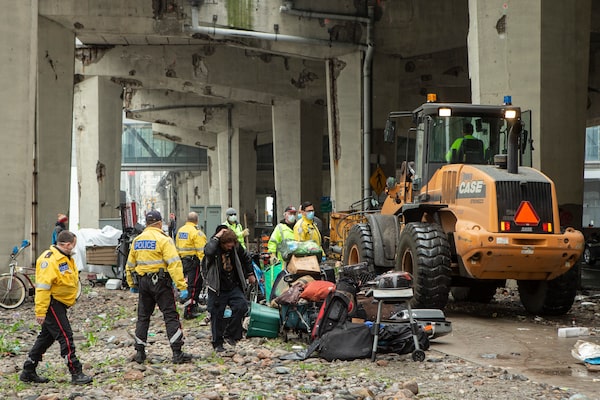
City workers and police officers move to clear an encampment on Toronto's Bay Street on May 15, 2020.Chris Young/The Canadian Press
Advocates for the homeless confronted city crews sent to clear up tents and debris under the Gardiner Expressway on Friday morning, the latest front in the battle between activists and city officials over Toronto’s response to the threat the novel coronavirus poses to some of its most vulnerable residents.
But within weeks, the fight over whether the city is doing enough to protect homeless people from the virus will move from the streets to the courts.
In a hearing now set for June 8, a judge will hear arguments from the Canadian Civil Liberties Association and other advocacy groups in a lawsuit, which also names the provincial government, that alleges Toronto’s treatment of the homeless during the pandemic violates the Charter of Rights and Freedoms.
In Friday’s confrontation under the Gardiner, Doug Johnson Hatlem, a street pastor with the downtown Christian charity Sanctuary, said city outreach workers initially only offered a homeless man at the site a spot in a shelter, where activists say crowding increases the risk of getting COVID-19. After a standoff, Mr. Johnson Hatlem said, the man agreed to move to one of the apartments or hotel rooms secured by the city during the pandemic.

Jason stands outside an encampment before it was cleared by city workers.Chris Young/The Canadian Press
“Beyond the outrage to basic human dignity, it seems like Toronto officials are insistent on spreading COVID-19 across the city like spores from a field of dandelions,” Mr. Johnson Hatlem said.
Mary-Anne Bédard, head of the city’s shelter department, said the man had only moved to the encampment after it had been slated for cleanup and its previous residents had been offered places indoors, as per city policy. Fire Chief Matthew Pegg warned that the increase in homeless people living in tents poses fire safety risks: One man died in a tent fire earlier this month.
Since the beginning of the pandemic, activists have raised alarms that achieving the recommended two metres of physical distancing was impossible in the city’s crowded shelters. Before the pandemic, beds were routinely placed as close as 75 centimetres from each other. Mr. Johnson Hatlem and other activists accuse the city of moving too slowly to address the issue.
As of Friday, 346 homeless people in the city had tested positive, up tenfold from a month ago. Two men, one in his 50s and another in his 70s, have died. Activists charge that testing has been sporadic and too slow.
What is the reopening plan in my province? A guide
Coronavirus guide: Updates and essential resources about the COVID-19 pandemic
The city argues it has mounted a massive response to minimize the threat. It says it has removed more than 2,500 people from the shelter system, which houses about 7,000 a night, and placed them in new shelters, leased hotel rooms or apartments. Ms. Bédard says this has allowed for physical distancing to be implemented for 95 per cent of its shelters spaces, meaning those beds are now spaced two metres apart. She said another 100 people being moved from shelters on the long weekend would see the system achieve 100 per cent in days.
Residents are also supposed to be screened for symptoms before entering a shelter for the night. And two recovery centres, in leased hotels, have opened to care for homeless people after they test positive.
But this narrative contrasts with material filed as part of the lawsuit, which claims that city shelters – including some set up after the pandemic began – were still forcing the homeless to sleep closer than two metres from other beds as recently as the end of April.

Toronto NDP MPP Rima Berns-McGown said the city is failing its homeless people and needs more funding from Queen’s Park.Chris Young/The Canadian Press
In an affidavit, Mr. Johnson Hatlem says that even as recently as April 30, residents or staff at eight downtown shelters told him that beds or cots were still less than two metres from each other.
His affidavit also includes photos taken by homeless people themselves in mid-April. The images, distributed on social media, appear to show cots closer than two metres together at two shelters the city set up in response to COVID-19.
And in stills from a cellphone video shot April 27 by a homeless man identified only as Nick, some mats appear closer than two metres together at one such site on the east side of downtown Toronto.
Councillor Joe Cressy, chairman of the city’s board of health, said he had faith in the 95-per-cent figure and that the city was doing all it can.
“I am confident that the city is reporting the facts and moving with everything they’ve got,” Mr. Cressy said. “Shelters are a stopgap and an emergency response. But if we are truly going to protect people from COVID-19, housing is the solution.”
Toronto NDP MPP Rima Berns-McGown, the Opposition’s poverty and homelessness critic, said the city is failing its homeless people and needs more funding from Queen’s Park.
“It’s a recipe for disaster,” she said. “For me, the bigger issue is that the city is just overwhelmed and can’t cope with the situation.”
Christopher Mio and Meghan Hoople found themselves jobless and wanting to help in the wake of COVID-19 isolation in Toronto. After flyering their neighbourhood with a free-of-charge offer, they received an outpouring of support and requests from people in need.
The Globe and Mail
Sign up for the Coronavirus Update newsletter to read the day’s essential coronavirus news, features and explainers written by Globe reporters.
 Jeff Gray
Jeff Gray